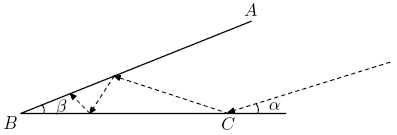Difference between revisions of "1994 AIME Problems/Problem 14"
(category) |
m (temp) |
||
| Line 5: | Line 5: | ||
== Solution == | == Solution == | ||
| − | {{ | + | === Solution 1 === |
| + | At each point of reflection, we pretend instead that the light continues to travel straight. | ||
| + | |||
| + | {{image}} | ||
| + | <asy> | ||
| + | pathpen = linewidth(0.7); size(250); | ||
| + | real alpha = 28, beta = 36; | ||
| + | pair B = D(MP("B",(0,0))), C = MP("C",D((1,0))), A = MP("A",D(expi(alpha * pi/180)),N); path r = C + .4 * expi(beta * pi/180) -- C - 2*expi(beta * pi/180); | ||
| + | D(A--B--(1.5,0));D(r);D(anglemark(C,B,A));D(anglemark((1.5,0),C,C+.4*expi(beta*pi/180)));MP("\beta",B,(5,1.2),fontsize(9));MP("\alpha",C,(4,1.2),fontsize(9)); | ||
| + | for(int i = 0; i < 180/alpha; ++i){ | ||
| + | path l = B -- (1+i/2)*expi(-i * alpha * pi / 180); | ||
| + | D(l, linetype("4 4")); | ||
| + | D(IP(l,r)); | ||
| + | } | ||
| + | </asy> | ||
| + | |||
| + | Then each intersection of the extended line with the rotated segments corresponds to a reflection in the original problem. We quickly see that the extended line will intersect each rotation of the angle by <math>k \beta</math> until <math>k\beta \ge 180 - \alpha \Longrightarrow k \ge \frac{180 - \alpha}{\beta}</math>. Thus, our answer is, including the first intersection, <math>\left\lceil \frac{180 - \alpha}{\beta} \right\rceil = \boxed{083}</math>. | ||
== See also == | == See also == | ||
Revision as of 19:34, 6 December 2008
Contents
Problem
A beam of light strikes ![]() at point
at point ![]() with angle of incidence
with angle of incidence ![]() and reflects with an equal angle of reflection as shown. The light beam continues its path, reflecting off line segments
and reflects with an equal angle of reflection as shown. The light beam continues its path, reflecting off line segments ![]() and
and ![]() according to the rule: angle of incidence equals angle of reflection. Given that
according to the rule: angle of incidence equals angle of reflection. Given that ![]() and
and ![]() determine the number of times the light beam will bounce off the two line segments. Include the first reflection at
determine the number of times the light beam will bounce off the two line segments. Include the first reflection at ![]() in your count.
in your count.
Solution
Solution 1
At each point of reflection, we pretend instead that the light continues to travel straight.
An image is supposed to go here. You can help us out by creating one and editing it in. Thanks.
![[asy] pathpen = linewidth(0.7); size(250); real alpha = 28, beta = 36; pair B = D(MP("B",(0,0))), C = MP("C",D((1,0))), A = MP("A",D(expi(alpha * pi/180)),N); path r = C + .4 * expi(beta * pi/180) -- C - 2*expi(beta * pi/180); D(A--B--(1.5,0));D(r);D(anglemark(C,B,A));D(anglemark((1.5,0),C,C+.4*expi(beta*pi/180)));MP("\beta",B,(5,1.2),fontsize(9));MP("\alpha",C,(4,1.2),fontsize(9)); for(int i = 0; i < 180/alpha; ++i){ path l = B -- (1+i/2)*expi(-i * alpha * pi / 180); D(l, linetype("4 4")); D(IP(l,r)); } [/asy]](http://latex.artofproblemsolving.com/5/d/7/5d7543d66ce2d6d2c9f40193f6f340ad12927ad1.png)
Then each intersection of the extended line with the rotated segments corresponds to a reflection in the original problem. We quickly see that the extended line will intersect each rotation of the angle by ![]() until
until ![]() . Thus, our answer is, including the first intersection,
. Thus, our answer is, including the first intersection, ![]() .
.
See also
| 1994 AIME (Problems • Answer Key • Resources) | ||
| Preceded by Problem 13 |
Followed by Problem 15 | |
| 1 • 2 • 3 • 4 • 5 • 6 • 7 • 8 • 9 • 10 • 11 • 12 • 13 • 14 • 15 | ||
| All AIME Problems and Solutions | ||










